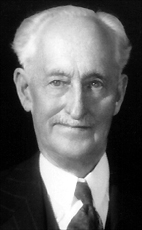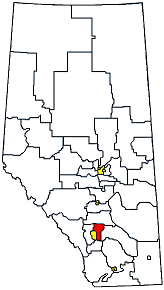| |||||||||||||||||||||||||||||||||||||||||||||||||
56 seats in the Legislative Assembly of Alberta 29 seats were needed for a majority | |||||||||||||||||||||||||||||||||||||||||||||||||
|---|---|---|---|---|---|---|---|---|---|---|---|---|---|---|---|---|---|---|---|---|---|---|---|---|---|---|---|---|---|---|---|---|---|---|---|---|---|---|---|---|---|---|---|---|---|---|---|---|---|
| |||||||||||||||||||||||||||||||||||||||||||||||||
 Map of 1913 Provincial electoral districts | |||||||||||||||||||||||||||||||||||||||||||||||||
| |||||||||||||||||||||||||||||||||||||||||||||||||
The Alberta general election of 1913 was the third general election for the Province of Alberta, Canada. The writ was dropped on 25 March 1913 and election day was held 17 April 1913 to elect members of the Legislative Assembly of Alberta. Elections in two northern districts took place on 30 July 1913 to compensate for the remote location of the riding. The method to elect members was under the First Past the Post voting system with the exception of the Edmonton district which returned two members under a plurality block vote. The writ period for the general election was very short being 23 days.

Alberta is a western province of Canada. With an estimated population of 4,067,175 as of 2016 census, it is Canada's fourth most populous province and the most populous of Canada's three prairie provinces. Its area is about 660,000 square kilometres (250,000 sq mi). Alberta and its neighbour Saskatchewan were districts of the Northwest Territories until they were established as provinces on September 1, 1905. The premier has been Rachel Notley since May 2015.

The Legislative Assembly of Alberta is one of two components of the Legislature of Alberta, the other being Elizabeth II, Queen of Canada, represented by the Lieutenant-Governor of Alberta. The Alberta legislature meets in the Alberta Legislature Building in the provincial capital, Edmonton. The Legislative Assembly consists of 87 members, elected first past the post from single-member electoral districts.
The Edmonton provincial electoral district existed in two incarnations from 1905 - 1909 and again from 1921 - 1955, with the city broken up into multiple constituencies in the other time-periods. The district was created when Alberta became a province, to encompass residents of the city of Edmonton on the northside of the North Saskatchewan River For a time, it was one of three multi-member constituencies in the province's history, the others being Calgary and Medicine Hat.
Contents
- Events leading to the election
- The campaign
- Election issues
- Gerrymandered boundaries
- Siftonism
- Results
- Summary
- Members of the Legislative Assembly elected
- 30 July 1913
- References
- See also
Premier Arthur Sifton led the Alberta Liberal Party into his first election as leader, after taking over from Alexander Rutherford. Premier Rutherford had resigned for his government's involvement in the Alberta and Great Waterways Railway Scandal but remained a sitting member. Sifton faced great criticism for calling the snap election, after ramming gerrymandered electoral boundaries through the legislature, running up the provincial debt and neglecting on promised railways. The Socialist Party carried the banner for labour- and farmer-minded voters in five constituencies; in others, Independent candidates were of distinctively leftist sentiment.

Arthur Lewis Watkins Sifton, PC (UK), PC (Can), KC, was a Canadian politician who served as the second Premier of Alberta from 1910 until 1917. He became a minister in the Government of Canada thereafter. Born in Ontario, he grew up there and in Winnipeg, where he became a lawyer. He subsequently practised law with his brother Clifford Sifton in Brandon, Manitoba, where he was also active in municipal politics. He moved west to Prince Albert in 1885 and to Calgary in 1889. There he was elected to the 4th and 5th North-West Legislative Assemblies; he later served as a minister in the government of Premier Frederick W. A. G. Haultain. In 1903, the federal government, at the instigation of his brother who was now one of its ministers, made Arthur Sifton the Chief Justice of the Northwest Territories. When Alberta was created out of a portion of the Northwest Territories in 1905, Sifton became its first chief justice.
The Alberta Liberal Party is a provincial political party in Alberta, Canada. Founded in 1905, it was the dominant political party until the 1921 election, with the first three provincial Premiers being Liberals. Since 1921, it has formed the official opposition in the Legislative Assembly of Alberta several times, most recently from 1993 until 2012. Fourteen Liberals have served as Leader of the Opposition of Alberta.
Edward Michener, the official opposition leader of the Conservative Party, ended up capitalizing on anger toward the Sifton government. He would lead the largest opposition to date in Alberta history. The Liberals would win a comfortable majority of seats despite being almost even in the popular vote. The Socialist Party vote would collapse and lose their only seat as Charles M. O'Brien went down to defeat at the hands of a Conservative.

Edward Michener was a politician from Alberta, Canada. He was born in Tintern, Ontario.
The Progressive Conservative Association of Alberta was a provincial centre-right party in the Canadian province of Alberta. The party formed the provincial government, without interruption, from 1971 until the party's defeat in the 2015 provincial election under Premiers Peter Lougheed, Don Getty, Ralph Klein, Ed Stelmach, Alison Redford, Dave Hancock and Jim Prentice. At 44 years, this was the longest unbroken run in government at the provincial or federal level in Canadian history.

Charles Macnamara "Charlie" O'Brien was a Canadian socialist activist and politician in Alberta, Canada. He served in the Legislative Assembly of Alberta from 1909 to 1913.





















